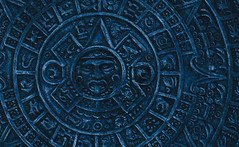Mayan Influence on Sonoran Desert Culture
Destination Arizona
B. Thomas Cooper
Editor
Experts believe the Mayan Indians played an important roll in the cultural advancement of the Sonora Desert region. The Mayas were among the most sophisticated peoples of the pre-Columbian era, credited with having developed written language as well as a complex and amazingly accurate calendar. Even before the discovery of metallurgy, the Maya were able to erect extraordinary structures using only stone and a simple form of mortar. The glory days of the Maya are gone now, but examples of their genius remain for us to appreciate.

Mayan Calendar
One such example of classic Maya genius is evident in their use of the Corbel Arch, a forerunner of the modern arch, and a huge engineering advancement for the period. Cut stones were arranged to form an upside-down ‘V’ shaped entryway, primarily supported by the weight (counter-weight) of the stones themselves.
The Maya were deeply spiritual, honoring their gods with extravagant works of art. Although the jungle has reclaimed much of what was once the Mayan empire, many examples of their culture remain. Because so many of these works were carved into solid stone, much of this artwork has survived the ravages of time, providing a glimpse into the daily lives of these amazing people. Recently, (Aug. 2008) a team of archaeologists uncovered a tunnel within a network of caves and sinkholes in central Mexico, leading to several previously unexplored Mayan buildings. According to translation from the ‘Popol Vuh‘, the sacred book of the Maya, this is the underground city of Xibalba, and represents one of the more important finds in Mayan history.
The Mayan Florescent period was perhaps their most creative era, producing impressive sculpture, hieroglyphs, pottery and exquisite figurines. These objects were created using essentially Neolithic techniques, relying on stone tools, made from granite, quartzite, limestone, obsidian and flint. Stones were utilized for a variety of tools. Some were split and hafted to create chisels and axes. Other were used for grinding, scraping and drilling purposes. Even after the discovery of metallurgy, metal tools remained rare in Mayan culture for many years.
Mayan builders utilized plumb lines, levels and other methods for squaring their structures, allowing for the construction of impressive temples, (Teocalli, or 'God House') and pyramids, many which still stand. A form of limestone based plaster was often applied to the exterior of buildings, creating a beautiful, white façade. Unfortunately, this process required burning excessive amounts of timber, resulting in deforestation, leading to a plethora of problems for the indigenous people, and perhaps contributing to their eventual downfall.
Indeed, the Mayans were an industrious people, and their contributions numerous. Although, as a society of peoples, they have vanished from existence, their legacy remains.
B. Thomas Cooper
Destination Arizona
Destination Arizona
Labels: B. Thomas Cooper, destination arizona, destinationarizona, Maya, Mayan influence, Popol Vuh, pre-columbian, sonora, sonoran culture, Xibalba

![Validate my Atom 1.0 feed [Valid Atom 1.0]](http://feedvalidator.org/images/valid-atom.png)

1 Comments:
A friend of mine mentioned 2012 last night to me and it's the first I heard about it so I jumped on here out of curiosity. I think it's kind of sick and sounds like a bunch of skeptical jargon.
I choose to live every day like it is the last because let's be real, WHO THE HELL KNOWS what is going to happen or when it's your time to go on. The past is history, the future is a mystery and now is a gift, thats why it's called the present. It's not healthy to sit around and trip out about when you will die. Stop wasting your time you have now.
[url=http://2012earth.net/who_are_we.html
]eschatology 2012
[/url] - some truth about 2012
Post a Comment
<< Home